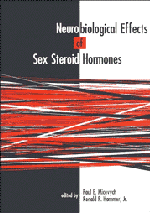Book contents
- Frontmatter
- Contents
- List of contributors
- Dedication
- Preface
- Acknowledgments
- Part I Sex steroid–responsive circuits regulating male and female reproductive behaviors
- Part II Sex steroid interactions with specific neurochemical circuits
- 5 Ovarian steroid interactions with hypothalamic oxytocin circuits involved in reproductive behavior
- 6 Sex steroid regulation of hypothalamic opioid function
- 7 Effects of sex steroids on the cholecystokinin circuit modulating reproductive behavior
- 8 Cholinergic regulation of female sexual behavior
- 9 Sex steroid regulation of tachykinin peptides in neuronal circuitry mediating reproductive functions
- 10 Dopaminergic influences on male rat sexual behavior
- 11 Studying neurotransmitter systems to understand the development and function of sex differences in the brain: the case of vasopressin
- Part III Cellular and molecular mechanisms regulated by sex steroids
- Index
7 - Effects of sex steroids on the cholecystokinin circuit modulating reproductive behavior
Published online by Cambridge University Press: 15 October 2009
- Frontmatter
- Contents
- List of contributors
- Dedication
- Preface
- Acknowledgments
- Part I Sex steroid–responsive circuits regulating male and female reproductive behaviors
- Part II Sex steroid interactions with specific neurochemical circuits
- 5 Ovarian steroid interactions with hypothalamic oxytocin circuits involved in reproductive behavior
- 6 Sex steroid regulation of hypothalamic opioid function
- 7 Effects of sex steroids on the cholecystokinin circuit modulating reproductive behavior
- 8 Cholinergic regulation of female sexual behavior
- 9 Sex steroid regulation of tachykinin peptides in neuronal circuitry mediating reproductive functions
- 10 Dopaminergic influences on male rat sexual behavior
- 11 Studying neurotransmitter systems to understand the development and function of sex differences in the brain: the case of vasopressin
- Part III Cellular and molecular mechanisms regulated by sex steroids
- Index
Summary
Introduction
During development and adulthood, the central nervous system (CNS) undergoes structural and neurochemical changes under the influence of endogenous stimuli. Among these stimuli are sex steroid hormones synthesized by the gonads, adrenal cortex, and CNS cells themselves (see Chapter 12 by Robel and Baulieu and Chapter 13 by Schlinger and Arnold, this volume). Sex steroid–sensitive neurons provide the anatomical substrate at which sex steroid hormones affect the structure and function of the CNS. Generally, these cells respond to the action of sex steroid hormones either directly, through hormone–receptor interaction, or indirectly, through trans-synaptic activation of membrane receptors and subsequently second messengers or immediate early genes.
In vertebrate species, most sex steroid–sensitive cells are part of the sexually differentiated limbic–hypothalamic circuit, which, within a more expansive neural network, controls reproductive events. To understand the functioning of the limbic–hypothalamic circuit, we must determine how sex steroids specify chemical connections within this circuit and how steroid hormone–induced changes in these connections are related to the display of sexual behavior. The phylogenetically conserved limbic–hypothalamic circuit consists of the posterior dorsal medial amygdala (MeA), encapsulated bed nucleus of the stria terminalis (BNST), medial preoptic nucleus (MPN), and ventromedial nucleus of the hypothalamus (VMH) (reviewed by Micevych and Ulibarri 1992). This circuit integrates a variety of neuronal inputs carrying somatic, olfactory, and hormonal information and sends projections to effector circuits to initiate neuroendocrine events (gonadotropin release) and sexual behavior (mounting or lordosis, reviewed by Pfaff and Schwartz-Giblin 1988).
- Type
- Chapter
- Information
- Neurobiological Effects of Sex Steroid Hormones , pp. 160 - 183Publisher: Cambridge University PressPrint publication year: 1995
- 4
- Cited by



